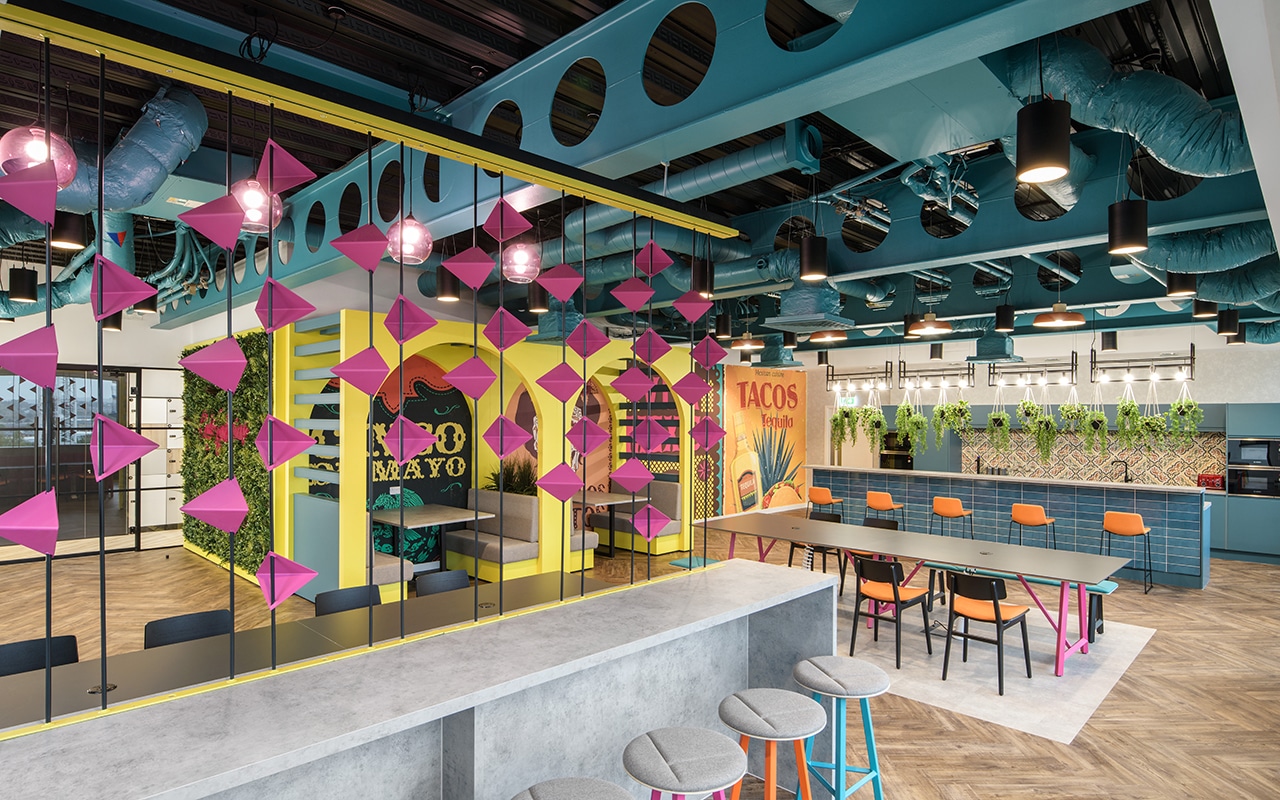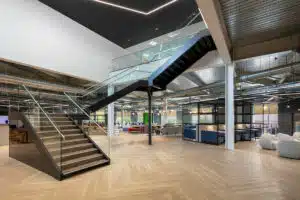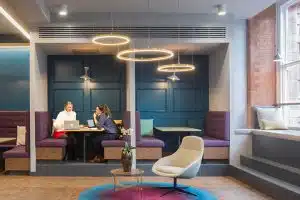Business leaders have faced new demands in recent years as people’s work habits have shifted, requiring them to reconsider if their office is suitable.
Whether a bigger premises is needed by your business to accommodate growth or to adapt to changing working patterns and behaviours, the right decision when it comes to choosing an office refurbishment or relocation is key – and not just to ensure a wise investment is being made. A truly effective workplace environment can improve employee satisfaction, productivity, and performance, and make it easier to recruit and retain talent, among other benefits.
In this blog, we take a look at the refurbishment vs relocation debate and explore the key considerations for companies who may be questioning which option would be best for their business.
Office refurbishment vs relocation: what’s the difference?
Before jumping in, it’s important to understand the differences between commercial office refurbishment and relocation:
- Refurbishment refers to renovating, refreshing or adapting your existing office space to improve functionality, space utilisation, aesthetics, and efficiency. The scope of the project can vary from simply updating office furniture and tweaking floor plans to stripping your office right back and rebuilding it.
- Relocation refers to moving a business from one physical location to another. It typically involves moving employees, furniture, equipment and supplies to an entirely new space.
Is office relocation or refurbishment right for our business?
When deciding between refurbishing your current workplace or moving office to a new location – there are several key factors to think about to work out what’s actually best for your business and your people. Realising later down the line that you’re on the wrong path is costly and frustrating, so it’s important to take the time to think carefully about your options upfront and seek expertise if you need it. You need to consider:
The ‘why’
Typically, a change in workplace requirements occurs due to an evolution in business size or structure, or due to new technology, culture or ways of working – or often a combination of these.
Start by asking yourself why you’re thinking about an office refurb or relocation. If it’s a case of the current space not working, why do you think this is? Perhaps you feel the current space is not conducive to employee productivity or the work environment is uninspiring? Or potentially you’re running out of space for your growing workforce or need to make a change to attract talent.
Conducting a comprehensive analysis of your existing workplace is important to inform the decision-making process. You need to know how you’re using your current workplace to know exactly what you need going forwards, and how you can cater for future requirements. Only by looking at this can you decide whether you need to move, or if reconfiguring your existing space could work.
Space
Figuring out how much space you need is a key driver. While you might consider using an office space calculator or a rule-of-thumb guide of square foot per person to work out if you have enough, too much, or need more space, these indicators often oversimplify. Workplace consultancy can provide a more nuanced, genuine expert recommendation on the space you require, and is more accurate than a standard office space estimator.
While identifying that you may have too much or too little space at your existing premises can point towards relocation, many challenges can be overcome by repurposing or rethinking the space you have. The pandemic caused a shift in how office space is being used. Workplaces are increasingly becoming spaces where collaboration, idea sharing, mentoring and socialising with colleagues takes place, while more focused/individual work is being carried out at home.
If you do offer hybrid working and don’t require a desk per person every day, you may be able to reconfigure your existing space to introduce more agile work settings. Consider whether any spaces are currently underutilised and how they’d better serve the business instead.
For example, you might decide to have fewer private meeting rooms to make way for more collaboration hubs or wellbeing spaces, depending on your requirements. Or, if you require more space but have decided your existing location is still right for the business, consider if there’s any available space in the building or nearby that you could expand into.
Location
Regardless of the size of your space, you also need to think about whether your current location is still working for you. Consider proximity to major roads, public transport, and free or affordable parking facilities to ensure accessibility for employees, clients and suppliers. It’s also important to plan your office to ensure access to essential and reliable infrastructure for electricity, water and the internet.
Assessing if the area is attractive to employees, or whether you need to be based somewhere else in order to attract talent, should also be high on your agenda. Considering that three quarters of UK firms already struggle to recruit staff, companies need to be mindful of how office location can pose another barrier to recruitment.
If your discussions and research is pointing more towards relocation, it’s crucial to consider how this will impact employees day-to-day lives. Moving to a new area will impact peoples’ commutes and could potentially put you at risk of losing staff members. Since people are typically resistant to change, it’s a good idea to consult with them to understand their perspective and bring them along on the journey. Employees need to feel that the new office justifies any changes or inconveniences they may experience along the way.
If your office requirements are the result of a merger or acquisition, relocation can often be the best option, as it allows for all employees and both cultures to come together in a more neutral territory – and in one which is aligned with the new business direction.
Amenities
Is the current building fit for purpose and does it have the amenities your business requires? Do you want to provide changing and shower facilities, dedicated wellbeing rooms, areas to socialise, or on-site health and fitness facilities? If the building or site doesn’t already cater for these or have space that can be effectively repurposed, you may need to look elsewhere.
Adding to that, if sustainability is among your business goals, consider whether the current building or workplace can be refurbished to become more sustainable. If extensive work is required to meet sustainability goals, relocation may be the better option.
Cost
If cost is a driving factor in your decision to relocate or refurbish, it’s important to think about how lease terms elsewhere compare with your current deal. However, long-term ROI should also factor.
While both relocation and refurbishment projects require significant up-front investment, it’s important to weigh up the long-term value of any choice you make. Not just in terms of attracting and retaining talent etc, but also operating costs. Newer buildings and office spaces are more likely to have modern and efficient systems which can help keep utility bills low.
Although costs will vary somewhat depending on the size and scope of your project, businesses typically find an office refurbishment more cost effective than relocating, as they tend to keep or utilise a lot of the existing equipment and infrastructure.
Relocating usually involves more up-front cost – finding a new space, negotiating leases, project management, removal companies, stamp duty, land tax, dilapidations, surveys, office fit out, covering solicitors’ costs etc. You will also likely be paying for two leases concurrently, keeping your existing office running while working on the new one.
How do the processes differ between office relocation and refurbishment?
The process typically takes longer for office moves because it involves extra steps. Employees are likely to take time to get used to a new office and location as they get used to new commutes and adapt to the new office layout, design and facilities.
That said, refurbs are more likely to cause disruption and downtime for your business. While simple aesthetic changes are unlikely to have too much of an impact, gutting and rebuilding the office would render it unusable. It’s important to consider where or how employees are going to work while the refurbishment is being done, whether employees work from home more during this period or use a nearby co-working space, and how to ensure business continuity.
How can ADT Workplace help with office refurbishment or relocation?
- Understand: Our expert consultants take time to understand your business, listen to your people, and learn about your ways of working and current space utilisation to shape a bespoke strategy.
- Find: We help find your perfect office space or identify the ways in which your current workplace can be optimised to meet your requirements. You can read about how we helped International Personal Finance with this here.
- Design: Our team of office interior design experts get to work to create transformational office designs to empower people and help businesses succeed.
- Build: Whether a fit out of a new office space or a workspace refurbishment, we bring your vision to life with our complete end to end service.
Take a look at our case studies to see how we’ve helped other businesses like yours.
For more guidance on your office or refurbishment project or workplace relocation you can speak with our team of consultants, by getting in touch here.




